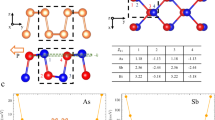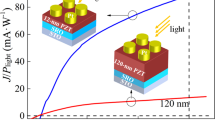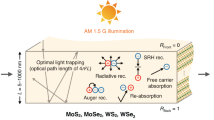Abstract
Ferroelectric absorbers, which promote carrier separation and exhibit above-gap photovoltages, are attractive candidates for constructing efficient solar cells. Using the ferroelectric insulator BaTiO3 we show how photogeneration and the collection of hot, non-equilibrium electrons through the bulk photovoltaic effect (BPVE) yields a greater-than-unity quantum efficiency. Despite absorbing less than a tenth of the solar spectrum, the power conversion efficiency of the BPVE device under 1 sun illumination exceeds the Shockley–Queisser limit for a material of this bandgap. We present data for devices that feature a single-tip electrode contact and an array with 24 tips (total planar area of 1 × 1 μm2) capable of generating a current density of 17 mA cm–2 under illumination of AM1.5 G. In summary, the BPVE at the nanoscale provides an exciting new route for obtaining high-efficiency photovoltaic solar energy conversion.
This is a preview of subscription content, access via your institution
Access options
Subscribe to this journal
Receive 12 print issues and online access
$209.00 per year
only $17.42 per issue
Buy this article
- Purchase on Springer Link
- Instant access to full article PDF
Prices may be subject to local taxes which are calculated during checkout




Similar content being viewed by others
Change history
31 August 2016
In the version of this Article originally published, in Fig. 3a, the units on the left-hand y axis were incorrect; they should have read '(A cm–2)'. This has now been corrected in the online versions of the Article.
References
Shockley, W. & Queisser, H. J. Detailed balance limit of efficiency of p-n junction solar cells. J. Appl. Phys. 32, 510–519 (1961).
O'Regan, B. & Gratzel, M. A low-cost, high-efficiency solar cell based on dye-sensitized TiO2 films. Nature 335, 737–740 (1991).
Grekov, A. A., Malitskaya, M. A., Spitsina, V. D. & Fridkin, V. M. Photoelectric effects in A5B6C7-type ferroelectrics-semiconductors with low-temperature phase transitions. Kristallografiya 15, 500–509 (1970).
Glass, A. M., von der Linde, D. & Negran, T. J. High-voltage bulk photovoltaic effect and the photorefractive process in LiNbO3 . Appl. Phys. Lett. 25, 233–235 (1974).
Sturman, B. & Fridkin, V. The Photovoltaic and Photorefractive Effects in Noncentrosymmetric Materials (Gordon and Breach, 1992).
Yang, S. Y. et al. Above-bandgap voltages from ferroelectric photovoltaic devices. Nature Nanotech. 5, 143–147 (2010).
Seidel, J. et al. Efficient photovoltaic current generation at ferroelectric domain walls. Phys. Rev. Lett. 107, 126805 (2011).
Alexe, M. & Hesse, D. Tip-enhanced photovoltaic effects in bismuth ferrite. Nature Commun. 2, 256 (2011).
Nechache, R. et al. Photovoltaic properties of Bi2FeCrO6 epitaxial thin films. Appl. Phys. Lett. 98, 202902 (2011).
Young, S. M. & Rappe, A. M. First principles calculation of the shift current photovoltaic effect in ferroelectrics. Phys. Rev. Lett. 109, 116601 (2012).
Young, S. M., Zheng, F. & Rappe, A. M., First-principles calculation of the bulk photovoltaic effect in bismuth ferrite. Phys. Rev. Lett. 109, 236601 (2012).
Kreisel, J., Alexe, M. & Thomas, P. A. A photoferroelectric material is more than the sum of its parts. Nature Mater. 11, 260 (2012).
Daranciang, D. et al. Ultrafast photovoltaic response in ferroelectric nanolayers. Phys. Rev. Lett. 108, 087601 (2012).
Yang, B. et al. Tuning the energy level offset between donor and acceptor with ferroelectric dipole layers for increased efficiency in bilayer organic photovoltaic cells. Adv. Mater. 24, 1455–1460 (2012).
Grinberg, I. et al. Perovskite oxides for visible-light-absorbing ferroelectric and photovoltaic materials. Nature 503, 509–512 (2013).
Fridkin, V. Parity nonconservation and bulk photovoltaic effect in a crystal without symmetry center. IEEE Trans. Ultrason. Ferroelect. Freq. Control 60, 1551–1555 (2013).
Bhatnagar, A., Roy Chaudhuri, A., Heon Kim, Y., Hesse, D. & Alexe, M. Role of domain walls in the abnormal photovoltaic effect in BiFeO3 . Nature Commun. 4, 2835 (2013).
Xiao, Z. et al. Ferroelectric materials: synthesis and application of ferroelectric P(VDF-TrFE) nanoparticles in organic photovoltaic devices for high efficiency. Adv. Energy Mater. 3, 1581–1588 (2013).
Nechache, R. et al. Bandgap tuning of multiferroic oxide solar cells. Nature Photon. 9, 61–67 (2015).
Zenkevich, A. et al. Giant bulk photovoltaic effect in thin ferroelectric BaTiO3 films. Phys. Rev. B 90, 161409 (2014).
Yuan, Y., Xiao, Z., Yang, B. & Huang, J. Arising applications of ferroelectric materials in photovoltaic devices. J. Mater. Chem. A 2, 6027–6041 (2014).
Chakrabartty, J. P., Nechache, R., Harnagea, C. & Rosei, F. Photovoltaic effect in multiphase Bi-Mn-O thin films. Opt. Express 22, A80–A89 (2014).
Malinovskii, V. K. & Sturman, B. I. Photoelectric effects in ferroelectrics with high-mobile nonequilibrium electrons. Ferroelectrics 43, 125–129 (1982).
von Baltz, R. & Kraut, W. Theory of the bulk photovoltaic effect in pure crystals. Phys. Rev. B 23, 5590–5596 (1981).
Wemple, S. H., DiDomenico, M. & Camlibel, I. Dielectric and optical properties of melt-grown BaTiO3 . J. Phys. Chem. Solids 29, 1797–1803 (1968).
Chynoweth, A. G. Surface space-charge layers in barium titanate. Phys. Rev. 102, 705–714 (1956).
Chen, F. S. Optically induced change of refractive indices in LiNbO3 and LiTaO3 . J. Appl. Phys. 40, 3389–3396 (1969).
Krogstrup, P. et al. Single-nanowire solar cells beyond the Shockley-Queisser limit. Nature Photon. 7, 306–310 (2013).
Kolodinski, S., Werner, J. H., Wittchen, T. & Queisser, H. J. Quantum efficiencies exceeding unity due to impact ionization in silicon solar cells. Appl. Phys. Lett. 63, 2405–2407 (1993).
Berglund, C. N. & Braun, H. J. Optical absorption in single-domain ferroelectric barium titanate. Phys. Rev. 164, 790–799 (1967).
Koch, W. T. H., Munser, R., Ruppel, W. & Wurfel, P. Anomalous photovoltage in BaTiO3 . Ferroelectrics 13, 305–307 (1976).
Jona, F. & Shirane, G. Ferroelectric Crystals (Dover, 1962).
Fridkin, V. Ferroelectric Semiconductors (Consultants Bureau, 1980).
Kang, M., Kim, I., Chu, M., Kim, S. W. & Ryu, J.-W. Optical properties of sputtered indium-tin-oxide thin films. J. Kor. Phys. Soc. 59, 3280–3283 (2011).
Data for Newport model LCS-100 94011A AM1.5G Fig. 1; https://assets.newport.com/webDocuments-EN/images/32057.pdf
Ross, R. & Nozik, A. Efficiency of hot-carrier solar energy converters. J. Appl. Phys. 53, 3813–3818 (1982).
Schaller, R. D. & Klimov, V. I. High efficiency carrier multiplication in PbSe nanocrystals: implications for solar energy conversion. Phys. Rev. Lett. 92, 186601 (2004).
Nozik, A. J. et al. Semiconductor quantum dots and quantum dot arrays and applications of multiple exciton generation to third-generation photovoltaic solar cells. Chem. Rev. 110, 6873–6890 (2010).
Semonin, O. E. et al. Peak external photocurrent quantum efficiency exceeding 100% via MEG in a quantum dot solar cell. Science 334, 1530–1533 (2011).
Green, M. Third Generation Photovoltaics: Ultra-High Efficiency at Low Cost (Springer, 2006).
Conibeer, G. Third-generation photovoltaics. Mater. Today 11, 42–50 (2007).
Acknowledgements
The authors thank L. Tan, F. Zheng, E. J. Mele, J. B. Baxter and I. Grinberg for discussions. J.E.S. acknowledges the support of the US Army Research Office through grant no. W911NF-14-1-0500. A.M.R. acknowledges the support of the Department of Energy through grant no. DE-FG02-07ER46431. Y.Q. and C.J.H. acknowledge the support of the Office of Naval Research through grant no. N00014-14-1-0761. S.M.Y. was supported by a National Research Council Research Associateship Award at the US Naval Research Laboratory. The authors acknowledge core materials characterization facilities at Drexel for access to electron and focused ion beam microscopy, including instrumentation supported by the National Science Foundation under grant no. DMR 0722845. The authors also acknowledge additional support from the National Science Foundation and the Semiconductor Research Corporation under the Nanoelectronics in 2020 and Beyond Program under grant no. DMR 1124696.
Author information
Authors and Affiliations
Contributions
V.M.F. and J.E.S. proposed the ideas and designed the experiments. V.M.F., A.R.A., Z.G., C.J.H., D.I., A.L.B.-J. and G.X. designed the optical and optoelectronic set-ups, collected photogenerated Hall and photocurrent data, and performed optical and microscopy measurements. J.E.S., V.M.F., A.M.R., A.P., S.M.Y., Y.Q. and C.L.J. contributed to analyses of the data and results, and validation of the model, including simulations. J.E.S. and V.M.F. wrote the manuscript, and with A.M.R., A.P., S.M.Y. and Y.Q., edited the manuscript.
Corresponding author
Ethics declarations
Competing interests
The authors declare no competing financial interests.
Supplementary information
Supplementary information
Supplementary information (PDF 633 kb)
Rights and permissions
About this article
Cite this article
Spanier, J., Fridkin, V., Rappe, A. et al. Power conversion efficiency exceeding the Shockley–Queisser limit in a ferroelectric insulator. Nature Photon 10, 611–616 (2016). https://doi.org/10.1038/nphoton.2016.143
Received:
Accepted:
Published:
Issue Date:
DOI: https://doi.org/10.1038/nphoton.2016.143
This article is cited by
-
Quantifying the photocurrent fluctuation in quantum materials by shot noise
Nature Communications (2024)
-
Giant intrinsic photovoltaic effect in one-dimensional van der Waals grain boundaries
Nature Communications (2024)
-
Peculiar band geometry induced giant shift current in ferroelectric SnTe monolayer
npj Computational Materials (2024)
-
Light control with Weyl semimetals
eLight (2023)
-
Giant bulk piezophotovoltaic effect in 3R-MoS2
Nature Nanotechnology (2023)



